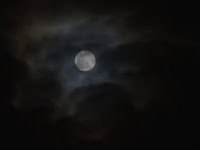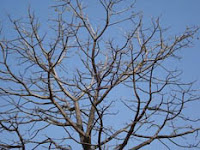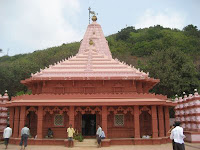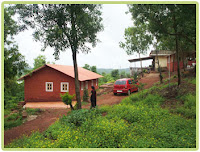Pages
▼
Saturday, March 26, 2011
Monday, March 21, 2011
GUDI PADWA
Celebrated on the first day of the Chaitra month of the Hindu calendar (March-April as per the Gregorian Calendar), Gudi Padwa marks the New Year's Day for Maharashtrians and Hindu Konkanis in India. The Brahma Purana declares Gudi Padwa to be the time on which Lord Brahma created the world after the great deluge. One of the 3 and a half days in the Indian Lunar calendar called "Sade-Teen Muhurt", whose every moment is considered auspicious in general to start a new activity..
Importance - The Beginning Of The Hindu Calendar.
The New Year day of the Maharashtrians, Gudi Padwa heralds the advent of a prosperous new year and is considered as one of the most auspicious days by Hindus. The Hindu year begins on the first day, "shuddha pratipada", of the month of Chaitra (March-April). It is one of the 'Muhurat' amongst the three and a half Muhurats that occur in Hindu calendar year. The day is considered auspicious for building or entering a new house, putting a child to school, or starting a business. With this day begins the new season, the spring.
It is believed that on 'Gudi Padva' :
-The Universe was created by Brahma.
-Satyuga (The Age of Truth and Justice) began.
-King Vali was killed by Rama.Shri Rama returned to Ayodhya victorious.
-This is one of the 3 and a half days in the Hindu Lunar calendar, whose every moment is considered auspicious.
It is a day of great festivity and rejoicing. People get up early and clean their houses, decorating them with intricate rangoli designs. New clothes are worn, and sweets made for the occasion include shrikhand, basundi, etc. Many homes also decorate the pots with coconuts, flowers and mango leaves, symbolizing nature's bounty to all.
On this day a pole named Gudi is erected in front of the house. Padwa is another name for "Pratipada", the first day of the lunar month. A new cloth is tied on the Gudi, a metal or silver vessel is put on to it and a garland of sweets is hung on it. People welcome the New Year with Gudi worship and distribute Prasad comprising of tender Neem leaves, tamarind, Ajwain, gram-pulse and jaggery. The Neem paste is believed to purify the blood and build up immunity in the body against diseases.
On the festive day, courtyards in village houses will be swept clean and plastered with fresh cow dung. Even in the city, people take the time out to do some spring-cleaning. Women and children work on intricate rangoli designs on their doorsteps, the vibrant colors mirroring the burst of color associated with spring. Everyone dresses up in new clothes and it is a time for family gatherings. Specialties like soonth panak and chana usal are eaten on this day. Traditionally, families are supposed to begin the festivities by eating the bittersweet leaves of the neem tree. Sometimes, a paste of neem leaves is prepared and mixed with ajwain, gul, tamarind and jaggery. All the members of the family consume this paste, which is believed to purify the blood and strengthen the body&-s immune system against diseases.The inner significance of this is to indicate that life is a mixture of good and bad, joy and sorrow, success and disappointment, and all of them have to be treated alike. All experiences have to be treated with equanimity. Every one should resolve to face calmly whatever happens in this year, accepting it with good grace.We all should rise above sorrow and happiness, success and failure. Auspicious days like Ugadi should be used for making resolutions to change our way of life and to purify our behavior by giving up all bad qualities.
People also listen to Panchanga (Panchanga Shravana-listening to the yearly calendar) on Ugadi. Experts will open the new Panchanga on the day and explain the forecast of rain, crop, storms, crop prices and other relevant things. Prediction of the whole year make people prepared to face any situation.
In Maharastra, shrikhand -a fragrant yogurt dessert, with poori-a fried puffy bread is prepared.
1. A number of stories are associated with the festival, prominent among them being the theory of creation and also the day when Lord Ram returned to Ayodhya after defeating King Ravana in Lanka.
The year begins on the first day of Chaitra of the Hindu calendar named as Shalivahan. It is named so after King Shalivahan from Paithan in Maharashtra.
2. Gudi Padwa is symbolic of love and devotion between the wife and husband. On this day newly married daughters with their husbands are invited for special meals and resents.
3. Unlike other festivals, Gudi Padwa, is a very family-oriented affair, but one can also take part in the yatra organised the previous day, where families bring diyas and float them on the lake.The whole lake is lit up with floating diyas which looks really beautiful.
Gudi Padwa marks the first day of Marathi Calendar and is celebrated primarily in the southern states like Maharashtra, Andhra Pradesh and Karnataka. A joyous festival, Gudi Padwa is also a sacred occassion and its origins can be traced back to various legends often embedded in Hindu religious scriptures.
The Brahma Purana holds that it was on a Gudi Padwa day that Lord Brahma created the world again after a devastating deluge and time began to tick from this day forth. The day marks the start of Satyug (era of truth and justice). Gudi Padwa is said to be one of the 3 and a half days in the Indian Lunar calendar called "Sade-Teen Muhurt". Every moment of this period is considered auspicious to start new ventures. The word ‘padwa’ is derived from Pratipada, the first day of a lunar month or the first day after no-moon day (Amavasya). Gudi Padwa is specially dedicated to the worship of Lord Brahma. Hence, special flags known as "Gudi"s are erected in honour of Lord Brahma. These are also called "Brahmadhvaj" or ‘the flag of Brahma’. Some also refer to it as ‘the flag of Indra’ (Indradhvaj).
After the Gudi is set up, everyone worships it and performs a prayer in honour of Lord Brahma.
As per another popular legend, hoisting the "Brahmadhvaj" commemorates the corronation of Rama after his return to Ayodhya from 14 years of exile. The setting up of the 'Gudi' before the main entrance of every house symbolizes similar arrangement by the people of Ayodhya to express their happiness over the victory of their beloved prince Rama over the demon king Ravana and his return to his own kingdom after a long gap. The 'Gudi' stood as a victory flag for the Ayodhyans. Gudi Padwa is said to mark this happy incident, an occassion of great significance for religious Hindus. It is also believed that on this day, Rama attained victory over King Bali.
For some Maharashtrians, the festival marks the conquests of the Maratha forces led by the great hero Chhatrapati Shivaji Maharaj. Maharashtrians have great regard and admiration for their famous Maratha leader who fought bravely to establish a Maratha kingdom free from Mogul domination.
According to this legend, the "Gudi" is evocative of the brave Marathas returning home from their successful expeditions of war. The festival is thus, a celebration of victory and prosperity.
A popular belief is that the displaying of the Gudi wards off evil and invites prosperity and good luck into the house.
Nava varshachya hardik shubhechya to you all!
Gudi Padwa -- New Year Day
The New Year day of the Maharashtrians, Gudi Padwa heralds the advent of a prosperous new year and is considered as one of the most auspicious days by Hindus. The Hindu year begins on the first day, "shuddha pratipada", of the month of Chaitra (March-April). It is one of the 'Muhurat' amongst the three and a half Muhurats that occur in Hindu calendar year. The day is considered auspicious for building or entering a new house, putting a child to school, or starting a business. With this day begins the new season, the spring.
It is believed that on 'Gudi Padva' :
-The Universe was created by Brahma.
-Satyuga (The Age of Truth and Justice) began.
-King Vali was killed by Rama.Shri Rama returned to Ayodhya victorious.
-This is one of the 3 and a half days in the Hindu Lunar calendar, whose every moment is considered auspicious.
It is a day of great festivity and rejoicing. People get up early and clean their houses, decorating them with intricate rangoli designs. New clothes are worn, and sweets made for the occasion include shrikhand, basundi, etc. Many homes also decorate the pots with coconuts, flowers and mango leaves, symbolizing nature's bounty to all.
On this day a pole named Gudi is erected in front of the house. Padwa is another name for "Pratipada", the first day of the lunar month. A new cloth is tied on the Gudi, a metal or silver vessel is put on to it and a garland of sweets is hung on it. People welcome the New Year with Gudi worship and distribute Prasad comprising of tender Neem leaves, tamarind, Ajwain, gram-pulse and jaggery. The Neem paste is believed to purify the blood and build up immunity in the body against diseases.
The Festivities
People also listen to Panchanga (Panchanga Shravana-listening to the yearly calendar) on Ugadi. Experts will open the new Panchanga on the day and explain the forecast of rain, crop, storms, crop prices and other relevant things. Prediction of the whole year make people prepared to face any situation.
In Maharastra, shrikhand -a fragrant yogurt dessert, with poori-a fried puffy bread is prepared.
Gudi Padwa Trivia
1. A number of stories are associated with the festival, prominent among them being the theory of creation and also the day when Lord Ram returned to Ayodhya after defeating King Ravana in Lanka.
The year begins on the first day of Chaitra of the Hindu calendar named as Shalivahan. It is named so after King Shalivahan from Paithan in Maharashtra.
2. Gudi Padwa is symbolic of love and devotion between the wife and husband. On this day newly married daughters with their husbands are invited for special meals and resents.
3. Unlike other festivals, Gudi Padwa, is a very family-oriented affair, but one can also take part in the yatra organised the previous day, where families bring diyas and float them on the lake.The whole lake is lit up with floating diyas which looks really beautiful.
Gudi Padwa Legends
Gudi Padwa marks the first day of Marathi Calendar and is celebrated primarily in the southern states like Maharashtra, Andhra Pradesh and Karnataka. A joyous festival, Gudi Padwa is also a sacred occassion and its origins can be traced back to various legends often embedded in Hindu religious scriptures.
The Brahma Purana holds that it was on a Gudi Padwa day that Lord Brahma created the world again after a devastating deluge and time began to tick from this day forth. The day marks the start of Satyug (era of truth and justice). Gudi Padwa is said to be one of the 3 and a half days in the Indian Lunar calendar called "Sade-Teen Muhurt". Every moment of this period is considered auspicious to start new ventures. The word ‘padwa’ is derived from Pratipada, the first day of a lunar month or the first day after no-moon day (Amavasya). Gudi Padwa is specially dedicated to the worship of Lord Brahma. Hence, special flags known as "Gudi"s are erected in honour of Lord Brahma. These are also called "Brahmadhvaj" or ‘the flag of Brahma’. Some also refer to it as ‘the flag of Indra’ (Indradhvaj).
After the Gudi is set up, everyone worships it and performs a prayer in honour of Lord Brahma.
As per another popular legend, hoisting the "Brahmadhvaj" commemorates the corronation of Rama after his return to Ayodhya from 14 years of exile. The setting up of the 'Gudi' before the main entrance of every house symbolizes similar arrangement by the people of Ayodhya to express their happiness over the victory of their beloved prince Rama over the demon king Ravana and his return to his own kingdom after a long gap. The 'Gudi' stood as a victory flag for the Ayodhyans. Gudi Padwa is said to mark this happy incident, an occassion of great significance for religious Hindus. It is also believed that on this day, Rama attained victory over King Bali.
For some Maharashtrians, the festival marks the conquests of the Maratha forces led by the great hero Chhatrapati Shivaji Maharaj. Maharashtrians have great regard and admiration for their famous Maratha leader who fought bravely to establish a Maratha kingdom free from Mogul domination.
According to this legend, the "Gudi" is evocative of the brave Marathas returning home from their successful expeditions of war. The festival is thus, a celebration of victory and prosperity.
A popular belief is that the displaying of the Gudi wards off evil and invites prosperity and good luck into the house.
Monday, March 14, 2011
ENJOY GUDHI PADWA
GUHAGAR - GANPATIPULE - NATE
April 1st: Early morning departure. Breakfast at Nagothane. Proceed to Parshuram Temple. Lunch at Guhagar. Rest. Evening proceed to Vyadeshwar Temple and Guhagar Beach. Dinner. Stay at Nisarg.
April 2nd: Breakfast at 7:30 am. Proceed to Ganpatipule via Rai - Bathgaon Bridge. On route visit Hedvi Ganesh Temple, Velneshwar Temple. Lunch at Hedvi.Evening prceed to Ganesh Darshan, Ganpatipule Beach and Keshav Sut Memorial. Stay at Atharva Residency.
April 4th: Breakfast at 7:30 am. Proceed to Mumbai.
Tour Concludes, But the relationship continues....................
NB.: The cost for Packages Mentioned herein are ex- Mumbai.
Thursday, March 10, 2011
KONKAN PACKAGES BY PURNA TRAVELS

AMBOLI – SAWANTWADI – MALVAN- 4N / 5D
GANAPATIPULE - GUHAGAR- 3N / 4D
EXOTIC RATNAGIRI- 6N/7D
DIVEAGAR - HARIHARESHWAR - RAIGAD- 2N / 3D
 AMBOLI – SAWANTWADI - MALVAN - VIJAYDURG- 5N / 6D
AMBOLI – SAWANTWADI - MALVAN - VIJAYDURG- 5N / 6DDREAMLAND DAPOLI- 2N / 3D
CELEBRATE HOLI IN GUHAGAR- 2N / 3D
GUHAGAR – DAPOLI- 2N / 3D
GUHAGAR – DAPOLI – DIVEAGAR – HARIHARESHWAR- 3N / 4D
GUHAGAR - GANPATIPULE - NATE- 3N / 4D

TEMPLE TOURISM - KONKAN- 7N / 8D
TEMPLE TOURISM – RAIGAD 01- 2N / 3D
TEMPLE TOURISM - RATNAGIRI 01- 2N / 3D
TEMPLE TOURISM - RATNAGIRI 02- 3N / 4D
TEMPLE TOURISM - RATNAGIRI 03- 6N / 7D
TEMPLE TOURISM - SINDHUDURG 01- 5N / 6D

MAGICAL KONKAN- 6N / 7D
MARLESHWAR – KARNESHWAR - GANPATIPULE- 2N / 3D
RAIGAD – SHIVTHAR GHAL- 1N / 2D
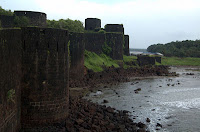 RAJAPUR – RATNAGIRI- 2N / 3D
RAJAPUR – RATNAGIRI- 2N / 3DNATE - MALVAN- 4N / 5D
FORT TOURISM - RATNAGIRI- 5N / 6D
Tuesday, March 8, 2011
VACATIONS IN KONKAN
There are a lot of beautiful Places with good Resorts & Hotels in the Konkan area, but are neglected due to the lack of information to tourists. Purna Travels is an attempt to fill this gap. It is an attempt to highlight the Konkan area as the Perfect Tourist Destination. Book your next vacation and build your own trip plans for Konkan at Purna Travels.
 Konkan is the coastal part of Maharashtra State and its scenic beauty rivals with that of Goa which is adjacent to Konkan. Because of neglect by Maharashtra State Government for decades, this great beautiful tourist spot was totally ignored by tourists due to lack of facilities, modern amenities and good hotels. This was the reason why Konkan remained the poorest part of Maharashtra State. Now all that has changed. In last 10 years, after realizing the importance of tourism in Konkan, Maharashtra Government finally realized their neglect and started developing Konkan from tourism point of view. And this right step by Government finally had great results to improve the economy of Konkan area as tourists have now started flocking to Konkan area to spend their valuable vacation time.
Konkan is the coastal part of Maharashtra State and its scenic beauty rivals with that of Goa which is adjacent to Konkan. Because of neglect by Maharashtra State Government for decades, this great beautiful tourist spot was totally ignored by tourists due to lack of facilities, modern amenities and good hotels. This was the reason why Konkan remained the poorest part of Maharashtra State. Now all that has changed. In last 10 years, after realizing the importance of tourism in Konkan, Maharashtra Government finally realized their neglect and started developing Konkan from tourism point of view. And this right step by Government finally had great results to improve the economy of Konkan area as tourists have now started flocking to Konkan area to spend their valuable vacation time.
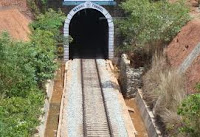 Konkan railway is one of the wonders of modern civil engineering and one has to travel by Konkan Railway to experience its beauty while travelling through innumerable tunnels and scenice mountains. Monsoon (June thru August) is the best time to travel by Konkan Railway although it is bit dangerous beacuse of possible landslides happening during heavy rains.
Konkan railway is one of the wonders of modern civil engineering and one has to travel by Konkan Railway to experience its beauty while travelling through innumerable tunnels and scenice mountains. Monsoon (June thru August) is the best time to travel by Konkan Railway although it is bit dangerous beacuse of possible landslides happening during heavy rains.
Konkan has a lot to offer to the visitor and its diverse geographical features are such that any tourist will definitely find something of his interest. No matter what kind of holiday you are looking for, You'll definitely enjoy your stay in Konkan with Purna Travels.
We are sure that you may not have even heard of many of the places in Konkan. Moreover, that is what we call
“DISCOVERING THE UNDISCOVERED KONKAN". Purna Travels is set to give you a memorable and pleasurable Konkan all the way.
WHY KONKAN TOURISM
 Konkan is the coastal part of Maharashtra State and its scenic beauty rivals with that of Goa which is adjacent to Konkan. Because of neglect by Maharashtra State Government for decades, this great beautiful tourist spot was totally ignored by tourists due to lack of facilities, modern amenities and good hotels. This was the reason why Konkan remained the poorest part of Maharashtra State. Now all that has changed. In last 10 years, after realizing the importance of tourism in Konkan, Maharashtra Government finally realized their neglect and started developing Konkan from tourism point of view. And this right step by Government finally had great results to improve the economy of Konkan area as tourists have now started flocking to Konkan area to spend their valuable vacation time.
Konkan is the coastal part of Maharashtra State and its scenic beauty rivals with that of Goa which is adjacent to Konkan. Because of neglect by Maharashtra State Government for decades, this great beautiful tourist spot was totally ignored by tourists due to lack of facilities, modern amenities and good hotels. This was the reason why Konkan remained the poorest part of Maharashtra State. Now all that has changed. In last 10 years, after realizing the importance of tourism in Konkan, Maharashtra Government finally realized their neglect and started developing Konkan from tourism point of view. And this right step by Government finally had great results to improve the economy of Konkan area as tourists have now started flocking to Konkan area to spend their valuable vacation time.There is lots of natural beauty in Konkan. Konkan has about 700 kilometers of beach and with heavy rainfall of about 300 inches during monsoon of 3 months, it has most beautiful greenery all over the area. Now Konkan is a tourist attraction because of beautiful clean beaches, Coconut and Beetelnut trees, rivers, mountain ranges of Sahyadri, ancient forts (especially Sindhudurg Fort) and good roads. It has very spectacular waterfalls. Almost 40% of Konkan is forest. There are lots of beautiful lakes. Konkan is full of natural beauty.
Agro (village) Tourism is slowly increasing in Konkan. The real culture of Konkan can be enjoyed only in its villages. In the villages you can see the art of pot makers, carpenters, gold smiths, tailors, cobblers, barbers. And by observing these arts, you will get real feel of Konkan. Also in the villages, you can enjoy delicious Konkani food especially various fish preparations which are unique to Konkan. In Konkan, coconut is used in almost every dish, since coconut is abundant in Konkan. There is a thriving flower industry because variety of flowers are grown all across Konkan. Barter system still exists in Konkan even in 21st century. Villagers of Konkan look very happy and contented despite their limited means.
Richness of Indian architecture can be seen in the villages while visiting ancient Temples. Even construction of houses is very unique in Konkan which is designed considering the heavy rainfall. Fishing is a big industry on which Konkan thrives as it has a long coastal area.
Many tourists come to Konkan to fulfill their desire for their adventure tourism. Like doing mountain trekking, motor biking in the forests, river crossing, snorkeling etc. Many come here for visiting religious places, some visit to see the heritage of Konkan area. Some visit for riding in backwaters.
 Konkan railway is one of the wonders of modern civil engineering and one has to travel by Konkan Railway to experience its beauty while travelling through innumerable tunnels and scenice mountains. Monsoon (June thru August) is the best time to travel by Konkan Railway although it is bit dangerous beacuse of possible landslides happening during heavy rains.
Konkan railway is one of the wonders of modern civil engineering and one has to travel by Konkan Railway to experience its beauty while travelling through innumerable tunnels and scenice mountains. Monsoon (June thru August) is the best time to travel by Konkan Railway although it is bit dangerous beacuse of possible landslides happening during heavy rains.Konkan is very famous for growing best mangoes in India. Especially, Alphanso (or Happus) Mango is grown very extensively throughout Konkan which brings lots of foreign exchange as large amounts of Mangoes are exported. In India, Mango is considered to be king of all fruits and Alphanso or Happus Mango from Konkan is the king of all different types of mangoes. And there is no doubt about it. I personally love Happus or Alphanso Mangoes. What a delicious taste!
Now who says that one has to visit Europe or USA to see natural beauty. We have Konkan right here in India to enjoy the nature. No need to go out of India to enjoy nature.
PHILOSOPHY OF PURNA TRAVELS
At Purna Travels, we help you make a choice that is just right for you. Our friendly, well-trained and knowledgeable tour advisors will give you sound and personalised advice so that you can make your tour a Dream Holiday.
You can select from 25 different Konkan Package for your Dream Holiday.
So, no matter where you are, if you want a perfect holiday, backed by advice you can trust, Purna Travels.
• If service was not important.
• If holiday was not complex.
• If packages were not confusing.
• We would have no reason to be in business.
• We help you design your holidays.
WHY PURNA TRAVELS
• Widest range of Konkan Packages
• We help you design your own Package
• Sound and knowledgeable advice to help you make your holiday a Dream Holiday
• A name you can trust
• Customer commitment
• Great deals and offers
• A first of its kind
Purna Travels Moto: YOUR DATES OUR MANAGEMENT
KONKAN - THE LAND OF SELF EXISTING GODS...
Purna Travels arranges tours for minimum 2 persons also , anywhere in Konkan.
Tuesday, March 1, 2011
MAHASHIVRATRI
Shivaratri, or Maha Shivaratri (Night of Shiva) is a Hindu festival, celebrated all over the country with great enthusiasm.
The festival usually falls every year on the 13th night/14th day in the Krishna Paksha of the month of Maagha (as per Shalivahana) or Phalguna (as per Vikrama) in the Hindu calendar.
The festival is exclusively dedicated to Lord Shiva who is known by hundreds of names.
Maha Shivratri is the day to rejoice…to pray to the almighty for wellness. Almost all Hindus throughout the world offer prayers in the morning/evening and some observe fasting ( vrata) throughout the day. Most people visit the nearby temples of Shiva and offer prayers in large crowds.
The prayers and worship continue throughout the night and the devotees offer coconut, Bilva leaves, fruits and specially prepared sacred food to Shiva and his divine consort Parvati.
As this is a dark fortnight, devotees light candles and diyas (a lamp made usually of clay, with wick made of cotton and dipped in ghee) throughout the night – this is a symbol of spiritual manifestation.
The festival usually falls every year on the 13th night/14th day in the Krishna Paksha of the month of Maagha (as per Shalivahana) or Phalguna (as per Vikrama) in the Hindu calendar.
The festival is exclusively dedicated to Lord Shiva who is known by hundreds of names.
Maha Shivratri is the day to rejoice…to pray to the almighty for wellness. Almost all Hindus throughout the world offer prayers in the morning/evening and some observe fasting ( vrata) throughout the day. Most people visit the nearby temples of Shiva and offer prayers in large crowds.
The prayers and worship continue throughout the night and the devotees offer coconut, Bilva leaves, fruits and specially prepared sacred food to Shiva and his divine consort Parvati.
As this is a dark fortnight, devotees light candles and diyas (a lamp made usually of clay, with wick made of cotton and dipped in ghee) throughout the night – this is a symbol of spiritual manifestation.


